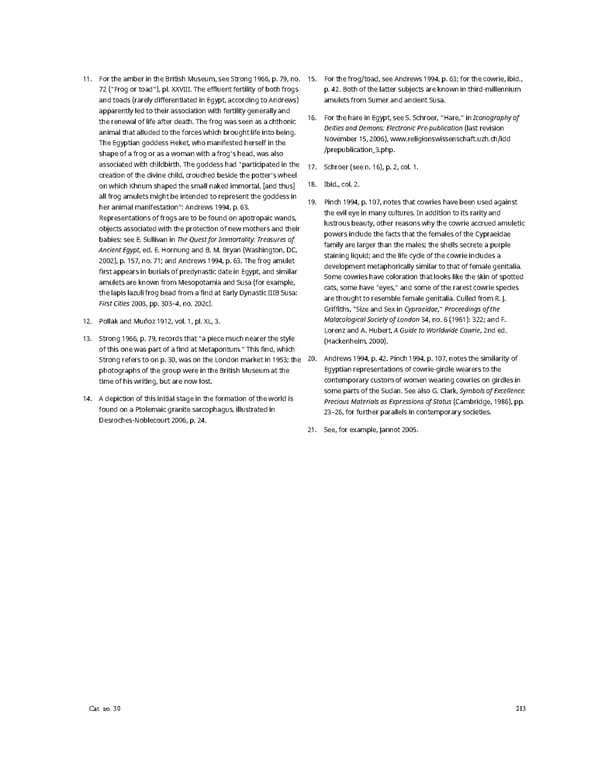11. For the amber in the British Museum, see Strong 1966, p. 79, no. 15. For the frog/toad, see Andrews 1994, p. 63; for the cowrie, ibid., 72 (“Frog or toad”), pl. XXVIII. The effluent fertility of both frogs p. 42. Both of the latter subjects are known in third-millennium and toads (rarely differentiated in Egypt, according to Andrews) amulets from Sumer and ancient Susa. apparently led to their association with fertility generally and 16. For the hare in Egypt, see S. Schroer, “Hare,” in Iconography of the renewal of life after death. The frog was seen as a chthonic Deities and Demons: Electronic Pre-publication (last revision animal that alluded to the forces which brought life into being. November 15, 2006), www.religionswissenschaft.uzh.ch/idd The Egyptian goddess Heket, who manifested herself in the /prepublication_3.php. shape of a frog or as a woman with a frog’s head, was also associated with childbirth. The goddess had “participated in the 17. Schroer (see n. 16), p. 2, col. 1. creation of the divine child, crouched beside the potter’s wheel on which Khnum shaped the small naked immortal, [and thus] 18. Ibid., col. 2. all frog amulets might be intended to represent the goddess in 19. Pinch 1994, p. 107, notes that cowries have been used against her animal manifestation”: Andrews 1994, p. 63. the evil eye in many cultures. In addition to its rarity and Representations of frogs are to be found on apotropaic wands, lustrous beauty, other reasons why the cowrie accrued amuletic objects associated with the protection of new mothers and their powers include the facts that the females of the Cypraeidae babies: see E. Sullivan in The Quest for Immortality: Treasures of family are larger than the males; the shells secrete a purple Ancient Egypt, ed. E. Hornung and B. M. Bryan (Washington, DC, staining liquid; and the life cycle of the cowrie includes a 2002), p. 157, no. 71; and Andrews 1994, p. 63. The frog amulet development metaphorically similar to that of female genitalia. first appears in burials of predynastic date in Egypt, and similar Some cowries have coloration that looks like the skin of spotted amulets are known from Mesopotamia and Susa (for example, cats, some have “eyes,” and some of the rarest cowrie species the lapis lazuli frog bead from a find at Early Dynastic IIIB Susa: are thought to resemble female genitalia. Culled from R. J. First Cities 2003, pp. 303–4, no. 202c). Griffiths, “Size and Sex in Cypraeidae,” Proceedings of the 12. Pollak and Muñoz 1912, vol. 1, pl. XL, 3. Malacological Society of London 34, no. 6 (1961): 322; and F. Lorenz and A. Hubert, A Guide to Worldwide Cowrie, 2nd ed. 13. Strong 1966, p. 79, records that “a piece much nearer the style (Hackenheim, 2000). of this one was part of a find at Metapontum.” This find, which Strong refers to on p. 30, was on the London market in 1953; the 20. Andrews 1994, p. 42. Pinch 1994, p. 107, notes the similarity of photographs of the group were in the British Museum at the Egyptian representations of cowrie-girdle wearers to the time of his writing, but are now lost. contemporary custom of women wearing cowries on girdles in some parts of the Sudan. See also G. Clark, Symbols of Excellence: 14. A depiction of this initial stage in the formation of the world is Precious Materials as Expressions of Status (Cambridge, 1986), pp. found on a Ptolemaic granite sarcophagus, illustrated in 23–26, for further parallels in contemporary societies. Desroches-Noblecourt 2006, p. 24. 21. See, for example, Jannot 2005. Cat. no. 30 213
 Ancient Carved Ambers in the J. Paul Getty Museum Page 222 Page 224
Ancient Carved Ambers in the J. Paul Getty Museum Page 222 Page 224